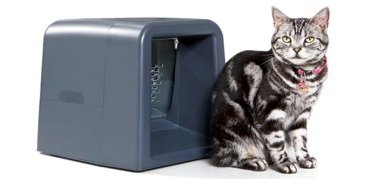RFID Opens Doors For Cats and Dogs at Home
 When it comes to a beloved dog or cat (or another domestic animal), most pet owners will spare no expense. Special food, life-enhancing medication, and lots of toys and bones are lavished on loyal animals by their humans.
When it comes to a beloved dog or cat (or another domestic animal), most pet owners will spare no expense. Special food, life-enhancing medication, and lots of toys and bones are lavished on loyal animals by their humans.
And that's why many pet industry marketers are looking to technology to improve the lives of both pets and their owners. One fast growing segment includes the use of radio frequency identification to make things easier at home.
After the successful introduction of RFID tags or "microchipping" for pet identification, sellers have expanded the range of radio frequency identification applications to include automated feeders and electronic pet doors. Here are a few of the products currently on the market.
RFID Pet Feeding By Gatefeeder
Conceived by a cat owner to solve the problem of feeding a special diet to one of his cats while he worked long hours, Gatefeeder is billed as the way to "feed the right meal to the right cat." Designed for cats (and even small dogs) weighing between five and twenty pounds, the system combines a Smart ID tag on the animal's collar with a door control mechanism on the feeder.
When the cat wants his dinner, he pushes the door of the feeder, "awakening" the RFID system. Based on the presence of the correct RFID tag, the door opens, and dinner is served.
Gatefeeder has everything the devoted (and busy) cat owner needs to give his pet the proper amount of food or medication while keeping other animals away and preventing so-called "competitive eating." The feeder can be used both indoors and out, and is similar in size and construction to many litter boxes.
The entrance is designed in such a way to prevent the cat from snagging his collar or head on any obstruction and allows just one cat's head and body through the door at once. A removable hood allows quick access in refilling the feeder. And the curious owner can even watch their cat through a viewing window without disturbing the dinner hour.
The automated feeder provides enough room for a weekend's worth of food for the average cat. And there's space for an ice pack which can be used to keep a portion of canned food cool for up to ten hours.
RFID Dog and Cat Doors
Entry doors for dogs and cats can give pets the freedom to come and go, also releasing their owners from the time honored tradition of holding doors open. But doors without some type of automation can pose risks for both pets and humans, allowing unwanted visitors. That's where RFID automation comes in.
Plexidor RFID Dog Doors
One example is the Plexidor electronic dog door. While there are electronic dog doors on the market that use technology other than RFID, industry experts often recommend against them. That's because these pet doors sometimes can open and close unintentionally based on signals coming from common household appliances like washers and dryers.
The RFID dog door is designed to roll up and down like a garage door. Similar to the RFID pet feeder, the complete system requires an electronic mechanism in the door along with an RFID tag that attaches to the dog's collar.
The RFID collar key can be programmed with thousands of key codes, is water proof and comes with a shatter-resistant panel, built to withstand plenty of wear. The pet door can be mounted on either an exterior door or wall.
As the dog approaches the door, the RFID sensor reads the collar key and slides the pet door open and closed, preventing other animals from entering.
Cat Mate Elite RFID Doors
Since many cats tend to be more active at night, cat doors can be a blessing for owners hoping to keep to a regular sleep schedule. And that's where the Elite RFID Super Selective door by Ani-mate comes in handy.
Designed to help monitor activity for as many as eight cats at a time, the system includes a door with a unique locking mechanism plus RFID tags for each cat's collar. Pet owners also have the ability to set specific access times for the door, keeping cats inside as needed.
A battery-powered LCD display shows whether or not the door is locked, and also gives the location (inside or out) of three cats, and the time elapsed since each entered or exited the door.
Engineered to prevent raccoons and other nuisance animals from entering the house, the cat door is designed specifically so that raccoons cannot get their fingers underneath the door flap to lift it up.
Using RFID technology, the busiest of pet owners can feed and keep track of their pets without a lot of extra work.
See related articles:
RFID Software Debuts Using A Simple Drag and Drop Interface
RFID Tags Designed to Reduce Truancy and Improve Safety In School
How Chip-Based Serialization Benefits Item level RFID
{jcomments on}
